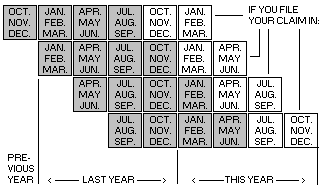Outdated or Unsupported Browser Detected
DWD's website uses the latest technology. This makes our site faster and easier to use across all devices. Unfortunatley, your browser is out of date and is not supported. An update is not required, but it is strongly recommended to improve your browsing experience. To update Internet Explorer to Microsoft Edge visit their website.
Unemployment Insurance Employer Handbook (UCB-201-P)
Section 1 - Benefits
Base Period. Only wages paid during the base period are used to determine if a claimant has qualifying wages to start an unemployment benefit year. Therefore, the first step is to identify the claimant's base period. The base period is the first four of the five most recently completed calendar quarters, counting from the quarter in which the claim is filed, not the quarter in which the claimant became unemployed.
The chart below illustrates which quarters would be in the base period (shaded) for a claim filed in the specified quarter.

If a claimant does not have enough wages to qualify for a claim using the base period defined above, an "alternate base period" will be used. The alternate base period will be the four most recently completed calendar quarters prior to the week the initial claim application for the new benefit year is filed.
Weekly Benefit Rate. The second step in determining whether a claimant has qualifying wages is to compute the potential weekly benefit rate. The base period quarter in which (s)he was paid the highest total amount of covered wages from all employers (the "high quarter") is used to compute the weekly benefit rate. The weekly benefit rate is equal to 4% of the covered wages paid by all employers in the high quarter, rounded down to the next whole dollar.
The maximum and minimum benefit rates are determined by UI law. Currently, the minimum weekly benefit rate is $54, requiring high quarter earnings of $1,350; and the maximum rate is $370, requiring high quarter earnings of $9,250.
Base Period Wages. Once the potential weekly benefit rate is computed, base period wages are reviewed to determine if the claimant meets the last two requirements, which are:
(See Part 6 for detailed information about base period wages.)
Additional Requirement for Some Claims. If the claimant was paid benefits in a prior benefit year which has ended, (s)he must also have worked since the beginning of that benefit year and earned at least 8 times the weekly benefit rate of that claim.
The maximum amount of benefits payable during a benefit year is the lesser of:
The maximum benefit amount is treated much like a checking account balance. As the claimant is paid unemployment benefits during the benefit year, the amount paid is subtracted from the balance until it reaches -0-. If the claimant is paid the full amount before the benefit year ends, no benefits can be paid to the claimant for the remainder of the benefit year, even if (s)he remains unemployed. Once the benefit year ends, any remaining entitlement from that benefit year can no longer be paid to the claimant. However, if the claimant is still unemployed, (s)he can attempt to start a new benefit year based on wages paid during the base period for that new claim.
If a claimant's very first initial claim application is filed on 04/13/24:
If the weekly benefit rate is $160 and the total base period wages are $10,000, the maximum benefit amount is the lesser of:
The claimant has the entire 52-week benefit year to collect the $4,000 maximum benefit amount. If the claimant returns to work in June of 2024 and stops filing for weekly benefits, the wages that are paid for this work will neither increase the weekly benefit rate nor will they increase the maximum benefit amount for the current benefit year. If the claimant is laid off again before 04/06/25 and has not been paid all of the $4,000 maximum benefit amount, (s)he can file another initial claim application to reactivate the benefit year and start filing for weekly benefits again.
If the claimant is still partially or totally unemployed in the week ending 04/12/25, (s)he can apply to start a new benefit year that week. Wages paid in the new base period, which begins 01/01/24 and ends 12/31/24, will be used to compute a new weekly benefit rate and a new maximum earnings amount if the claimant was paid enough wages in the new base period to qualify and (s)he has earned at least 8 times the prior weekly benefit rate since the beginning of the last benefit year.
In addition to having sufficient wages in the base period, the claimant must meet the following requirements to be eligible for benefits:
Work Search for Suitable Work. A claimant must conduct four work search actions in each week unless the work search requirement is specifically waived by the department. Some of the reasons that permit waiving the requirement include:
If a claimant fails to conduct four work search actions when required to do so, (s)he will not be eligible for benefits for the week(s) in question. See Part 7 for more information about this eligibility issue.
Updated: February 26, 2024